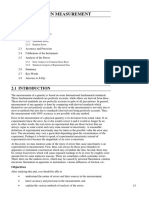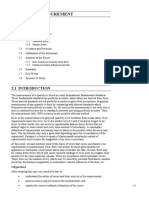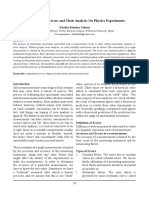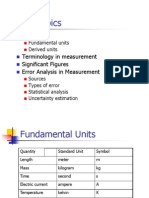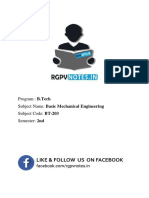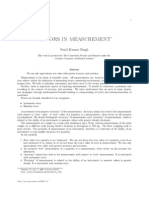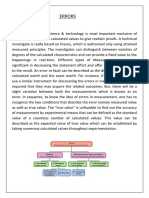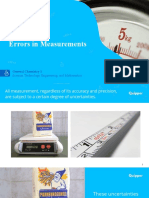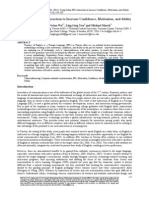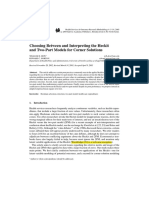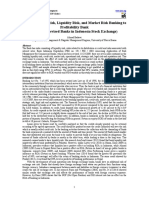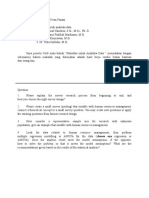Unit 2 Error Analysis Final
Uploaded by
Michael edwin vadivelUnit 2 Error Analysis Final
Uploaded by
Michael edwin vadivellOMoARcPSD|49469381
Unit 2 Error Analysis Final
BSc Chemistry (Mahatma Gandhi University)
Scan to open on Studocu
Studocu is not sponsored or endorsed by any college or university
Downloaded by Michael edwin vadivel (mohanv4549@gmail.com)
lOMoARcPSD|49469381
Error Analysis
UNIT
UNIT II
II ERROR ANALYSIS
ERROR ANALYSIS
Structure
II.1 Introduction
Objectives
II.2 Types of Errors
Systematic Errors
Random Errors
II.3 Estimating the Magnitude of Error
II.4 Propagation of Errors
Error Propagation in Basic Operations
Error Propagation in Angular Measurements
Error Propagation due to Exponent of a Measured Quantity
II.5 Error Propagation in Graphing
Plotting a Graph
Error Estimation on Graphical Plots
II.6 Summary
II.7 Terminal Questions
II.8 Solutions and Answers
R E
e l
s o
i n
s g
t a
a t
n i
c o
e n
100 200 300 400 500
Applied weight (N)
Temperature (C)
17
Downloaded by Michael edwin vadivel (mohanv4549@gmail.com)
lOMoARcPSD|49469381
Some Experiments on
Oscillations and Waves
II.1 INTRODUCTION
In Unit I you have learnt that the result of any measurement is expressed in
the form of numbers. You also know that every measuring device has a least
count, which is an indicator of its ability to measure a physical quantity upto a
particular accuracy limit. It means that the number obtained as a result of (a
series of) measurement(s) cannot be said to be ‘exact’. Further, there can be
defects in measuring instruments and even a very careful experimenter is
susceptible to certain personal errors.
Since limitations of instruments arise in the form of their least counts, it is
important that an instrument with appropriate accuracy is selected for
measurement. Note that even then it may not be possible to measure a
quantity exactly. That is, the measured value of a physical quantity is normally
different from its true value. The uncertainty in any number obtained from a
measurement constitutes what is referred to as error. It is important to note
that within an experiment, the error accumulates in different measurements.
In this unit, you will learn about the types and sources of errors in detail. You
will also learn to estimate and possibly eliminate or minimise and account for
such errors. In most of the physics experiments, our objective is to determine
relationship among physical quantities. Therefore, we estimate errors in
measurement of various physical quantities and try to establish valid
relationships. In the experimental write-ups of this course, you will learn to
apply the knowledge of errors and their propagation in actual measurements.
You will first perform measurements of fundamental quantities such as mass,
length and time, and then do experiments involving two or more physical
quantities.
Objectives
After studying this unit, you should be able to:
• identify the types and sources of errors;
• distinguish between random errors and systematic errors;
• compute errors in the measurement of various physical quantities;
• establish functional relationship between various physical quantities;
• use the criterion of best fit in a straight line plot; and
• interpret a graph and determine the values of physical quantities of interest.
II.2 TYPES OF ERRORS
In Unit I you have learnt that errors can arise due to limitations of measuring
instruments as they cannot measure smaller than their least count. For
instance, a metre scale cannot measure less than 0.1 cm, a vernier callipers
measures a minimum of 0.01 cm and a screw gauge cannot measure
distances less than 0.001 cm. Similarly, a thermometer can measure
18
Downloaded by Michael edwin vadivel (mohanv4549@gmail.com)
lOMoARcPSD|49469381
Error Analysis
temperature to an accuracy of half a degree Celsius. When measuring angles,
a simple protractor measures to an accuracy of one degree. But when a
vernier is attached to the protractor, as in a spherometer or spectrometer, we
can measure angle more precisely, up to 30″.
In addition to the limitations listed above, which are inherent in the measuring
devices, other sources of error could be (i) changes in environment, (ii) faulty
observation techniques, (iii) malfunctioning of measuring devices, etc.
The errors in any measurement can be classified in two broad categories:
Systematic Errors and Random Errors. Let us now learn about these in detail.
II.2.1 Systematic Errors
The systematic errors, also called ‘determinable’ errors, arise due to
identifiable causes. For this reason, these can, in principle, be eliminated or
corrected. These errors result in measured values being either consistently
high or low, i.e., different from the true value. The systematic errors include:
Zero Error arises due to wear and tear caused by extensive use. The zero of
the vernier scale may not coincide with the zero of the main scale when the
jaws are put in contact. The magnitude and nature (positive or negative) of the
zero error can be easily determined and corrected. In case of positive zero
error, the zero of the vernier scale is on the right of the zero of main scale and
vice versa. So, for positive zero error, we subtract (and add in case of
negative zero error) the value of error from the measured value.
Backlash Error in a screw gauge, a travelling microscope or a spherometer,
can arise due to wear and tear or defective fitting in the instrument. In this
case, a forward or backward rotation may not produce the same result. This is
minimised by rotating the screw head of the measuring device in only one
direction from the initial to the final point of measurement. Note that forward
and backward rotations, if resorted to, in the experiment even for finer
adjustments can induce errors.
End Correction arises when the edge (zero marking) of a scale is not distinctly
visible due to worn out. This leads to an error if one tries to keep the zero of
the scale at the starting point. This can be eliminated easily by shifting the
reference point of the scale to a definite and distinct point (say, 1 cm mark).
Errors due to changes in a physical quantity can take place during the course
of the experiment. For example, the resistance in electrical circuits can
change due to the heat generated on passing current through it. This leads to
errors that are generally difficult to calculate or compensate for. However, this
can be avoided to some extent by allowing the current to flow in the circuit
only when observations are being taken.
Defective or improper calibration in instruments such as ammeter or voltmeter
leads to errors in the measurement. In this case, there will be a constant
difference between measured and true values. This arises due to
19
Downloaded by Michael edwin vadivel (mohanv4549@gmail.com)
lOMoARcPSD|49469381
Some Experiments on
manufacturing defect. The best option in such a situation is to calibrate the
Oscillations and Waves
instrument against standard equipment.
Faulty observation can also arise due to parallax. To minimise error due to
When an observer
parallax, you should note the reading along the line, which is normal to say,
experiences relative both the scale and the edge of the table on which scale is placed. In fact, the
movement of an object and error due to parallax can be avoided, if the metre scale is placed on the edge
its image, there exists a
parallax between them. of the table while making measurement.
II.2.2 Random Errors
You must have noticed that if the same measurement is repeated for the
same quantity, you may get different readings with a scatter of values
distributed about some mean value. These are called random errors and can
arise due to accidental errors in the measurement process. These errors are
unavoidable, though sources of random errors can not always be identified.
The Observational random errors arise due to error of judgment of the
observer while reading the smallest division in the scale (like the coincident
vernier division with the main scale division). To minimise observable random
errors, you should always take more readings and calculate their mean or
draw the best fit graph.
If the values obtained in several measurements are x1, x2, x3, …, xN, the
average value is determined by adding all the values and dividing their sum by
the total number of observations:
x1 + x 2 + x 3 + ... + x N
x= . (II.1)
N
The Environmental random errors can arise due to unpredictable fluctuations
in line voltage, sudden changes in temperature or mechanical vibrations, etc.
There could also be a random spread of readings due to friction or wear and
tear of mechanical part(s) of the system.
Random error can also be induced by a careless experimenter, who does not
concentrate in his/her work in the laboratory. The errors arising out of this
situation can not be determined in any way. That is why, we have, in the
Course Introduction, highlighted the importance of observing decency in the
laboratory and careful handling of various instruments while performing an
experiment.
When inexact values are used in a calculation, some error or uncertainty in
the result is inevitable. The quality of a measurement and reliance on the
result so obtained are determined by the magnitude of the estimated error. In
scientific work, it is customary to quote a result along with associated error in
measurement (with proper units) and upto the same order of magnitude.
The random errors can be quantified by statistical analysis and expressed as
absolute error or relative error.
20
Downloaded by Michael edwin vadivel (mohanv4549@gmail.com)
lOMoARcPSD|49469381
Error Analysis
Spend
3 min.
Classify the following according to the type of error involved by putting a
tick in the appropriate column:
Sl. Measurement Type of Error
No.
Systematic Random
i) A time interval measured using
a stop watch that is running
slow
ii) The length of a piece of steel
rod is measured by several
students in a laboratory
iii) A steel scale expands on a hot
day to give a short reading of
length
iv) The needle of a voltmeter is
bent such that it does not rest
on zero
v) The number of nuclear particles
emitted per second by a lump of
radioactive element
Let us now learn to estimate the magnitude of errors.
II.3 ESTIMATING THE MAGNITUDE OF ERROR
Refer to Table II.1, where typical values of measurement of time period are
given. As such, by looking at the data, we cannot identify the “true” value.
Table II.1: A set of typical values of measurement
Data (xi) Deviation xi = xi − x
S. No. (s)
(s)
1. 2.69 0.01
2. 2.67 0.01
3. 2.68 0.00
4. 2.69 0.01
5. 2.68 0.00
6. 2.69 0.01
7. 2.66 0.02
8. 2.67 0.01
x = 2.68 x = 0.009
The magnitude of the difference between the actual (or the mean) value of a
physical quantity and its individual measured value is known as absolute
error in the measurement. Let us denote it by ∆ xi. If N independent
measurements of a quantity are labelled as x1, x2, …, xN , the average value is
given by Eq. (II.1). In summation notation, we can write
N
x= 1 xi .
N i =1
21
Downloaded by Michael edwin vadivel (mohanv4549@gmail.com)
lOMoARcPSD|49469381
Some Experiments on
Oscillations and Waves Read the symbol Σ as sigma and it represents the sum of all the
measurements. As you can see from Table II.1, the average value of time
period is 2.68 s. To calculate absolute error, we calculate the modulus of
individual deviations ∆x i = x i − x from the average value. Then, these
deviations are added and their sum is divided by the total number of
observations. Mathematically we can write,
N
∆x i
i =1
∆x = . (II.2)
N
For the data given in Table II.2, the average value of absolute error is 0.009s.
So we express the result of measurement as (2.68 ± 0.01) s. Note that
absolute error has the same units as the quantity measured.
In error analysis, a useful measure of deviation is the variance. That is,
variance is a measure of the spread of a distribution. For N observations, the
variance in summation notation is given by
N
(∆xi ) 2
2 i =1
σ = . (II.3)
N
Once variance is known, its square root gives standard deviation.
The standard deviation represents the range over which measurements vary.
In other words, the standard deviation equals the magnitude of the uncertainty
in the measurements.
You must be wondering as to why we consider standard deviation and not the
average of mere deviations. This is because the individual deviations (which
is also an indication of error involved in measurement) may be positive or
negative. Since errors are additive in nature, it is more appropriate to take
average of squares of the deviations and calculate standard deviation.
To give you a feel of the numbers, we would like you to answer the following
SAQ.
The measurement of the length of a table yields the following data:
1 = 135.0 cm, 2 = 136.5 cm, 3 = 134.0 cm, and 4 = 134.5 cm
Calculate the standard deviation and express the final result with
possible error involved.
A better index of the accuracy of a measurement or equipment is relative
error, also called percentage error. In fact, we quite often express our result
by quoting the relative error rather than the absolute error. The relative error is
22
Downloaded by Michael edwin vadivel (mohanv4549@gmail.com)
lOMoARcPSD|49469381
Error Analysis
the ratio of absolute error to the mean measured value of the quantity
expressed in percent:
δx = ∆x × 100. (II.4)
x
Note that we have written the relative error as δx to differentiate it from the
absolute error. You will note that the relative error covers all or most of the
readings.
II.4 PROPAGATION OF ERRORS
You now know how to calculate error in the measurement of a directly
observable physical quantity. But in most experiments, you will be required to
measure two or more independent quantities to determine a physical quantity
of interest. Therefore, the error in the final result depends on the errors in the
measurement of individual quantities. In other words, the error in each
measurement will “propagate” and get reflected in the final result. The actual
analysis of propagation of errors is beyond the scope of this laboratory work.
We shall, therefore, quote some useful rules.
II.4.1 Error Propagation in Basic Operations
To understand how error propagates through basic mathematical calculations,
we first consider addition and subtraction of two or more numbers.
Addition and Subtraction
Suppose that two physical quantities A and B have measured values ( A ± ∆A)
and (B ± ∆B ) , respectively, where ∆A and ∆B are their absolute errors. Let
us calculate the error ∆Z in their sum Z = A + B.
We have by addition
Z ± ∆Z = (A ± ∆A ) + (B ± ∆B ).
The maximum possible error in Z is therefore
∆Z = ∆A + ∆B .
For the difference Z = A − B,
Z ± ∆Z = (A ± ∆A ) − (B ± ∆B )
= A − B ± ∆A ± ∆B
or
± ∆Z = ± ∆A ± ∆B . (II.5)
The maximum value of the error ∆Z is sum of individual errors ( ∆A + ∆B ).
Hence the rule for propagation of errors for a sum or a difference is: The
absolute error in the final result is the sum of the absolute errors in
individual quantities.
23
Downloaded by Michael edwin vadivel (mohanv4549@gmail.com)
lOMoARcPSD|49469381
Some Experiments on
As such, Eq. (II.5) over-estimates the error. A more useful expression for ∆Z
Oscillations and Waves
based on statistical analysis is
∆Z = (∆A) + (∆B )
2 2
. (II.6)
Let us now calculate a propagating error in the following example.
The measured values of two lengths L1 and L2 are (1.746 ± 0.001) m and
(1.507 ± 0.001) m, respectively. Calculate the total error in measurement.
Solution:
The error in measurement would be equal to the sum of errors in L1 and L2.
Thus
∆L = (0.001 + 0.001) m = 0.002 m
and you can express the result as
L = (3.253 ± 0.002) m
If you use statistical analysis, you will obtain
∆L = (∆L ) + (∆L )
1
2
2
2
= ( 0.001m) 2 + ( 0.001m) 2
= 0.0014
= 0.001 m
Note that we have kept only positive root because errors are cumulative.
Multiplication and Division
If a quantity E = A × B and the results of measurement of A and B are
(A ± ∆A ) and (B ± ∆B ), respectively, we can write
E ± ∆E = (A ± ∆A ) × (B ± ∆B )
= AB ± B ∆A ± A ∆B ± ∆A ∆B .
Dividing by E = AB throughout, we obtain
∆E ∆A ∆B ∆A ∆B
1± = 1± + + . (II.7)
E A B AB
∆A ∆B
Since ∆A and ∆B are small, the term . can be neglected. Hence
AB
Eq. (II.7) can be rewritten as
24
Downloaded by Michael edwin vadivel (mohanv4549@gmail.com)
lOMoARcPSD|49469381
Error Analysis
∆E = ± A ∆B ± B ∆A .
The maximum error in E is given by
∆E ∆A ∆B
= + . (II.8)
E A B
Let us now consider the propagation of errors when the operation ‘division’ is
A
carried out. If we write E = , the error ∆E will be given by Eq. (II.8). We
B
leave this as an exercise for you.
If you take logarithm of E = AB and differentiate it, you will get
∆E ∆A ∆B
= + . This is generally known as the logarithmic error.
E A B
If you make statistical analysis, you will get the following result:
2 2
∆E ∆A ∆B
= + . (II.9)
E A B
You can now conclude that when independent measurements are multiplied
or divided, the fractional error in the result is the square root of the sum of the
squares of fractional errors in individual quantities. These results hold for
absolute errors as well as relative errors.
Now study the following example.
In an experiment, we calculate velocity from measurements of displacement
and time. If the displacement is S ± S = (0.63 ± 0.02) m and time is
t ± ∆t = (1.71 ± 0.10) s, calculate the error in velocity measurement.
Solution:
We know that velocity is rate of change of displacement:
S 0.63
v= = = 0.37 ms −1 .
t 1.71
The fractional errors in displacement and time are given by
∆S = 0.02 m = 0.03 ,
S 0.63 m
and
∆t = 0.1 s = 0.06.
t 1.71 s
25
Downloaded by Michael edwin vadivel (mohanv4549@gmail.com)
lOMoARcPSD|49469381
Some Experiments on
Hence the fractional error in v is
Oscillations and Waves
2 2
∆v = ∆S + ∆t
v S t
= 0.07
so that
∆v = 0.37 ms−1 × 0.07 = 0.03 ms−1.
Hence
v ± ∆v = (0.37 ± 0.03) ms−1.
Note that we have given the velocity to the second decimal. This is because
the error is up to the second decimal
Let us now see how error propagates in calculations involving operations of
both multiplication and division.
A particular physical quantity, in an experiment, is computed from the
XY
relation B = . Take the values of X, Y and Z measured in the laboratory
Z
as:
X = 17 ± 10%
Y = 100 ± 6
and
Z = 15 ± 3
Let us see how error propagates in such a situation.
Solution:
By converting the uncertainties to percentage, you will get
(17 ± 10%) × (100 ± 6%)
B=
(15 ± 20%)
= 113.3333 ± 36%,
where we have added the uncertainties.
Proceeding further, you will note that 36% of 113.3333 = 40.799988 so that
B = 113.3333 ± 40.8000
26
Downloaded by Michael edwin vadivel (mohanv4549@gmail.com)
lOMoARcPSD|49469381
Error Analysis
This means that the uncertainty in the value of B is about 41. So, it makes
no sense to retain the digits after the decimal in the value of B as well as
the uncertainty. It is therefore more sensible to write
B = 113 ± 41.
II.4.2 Error Propagation in Angular Measurements
In your B.Sc. physics laboratory, you will get an opportunity to make very
accurate and high precision measurements of angles. This is particularly true
of experiments involving small physical quantities such as wavelength using a
grating and a spectrometer. A spectrometer has a fixed circular protractor with
a vernier moving over it. Usually the least count of a spectrometer is 1 min of
th
an arc or 1 of a degree. The calculations of error propagation are the
16
same as in other measurements. This is illustrated below.
In a diffraction grating experiment, the wavelength λ = N sinθ, where N is the
number of rulings in the grating and θ is the angle of diffraction for that λ.
Then
∆λ = N cos θ = cot θ .
λ N sin θ
II.4.3 Error Propagation due to Exponent of a
Measured Quantity
Suppose we have to calculate the area of a square piece of land of side A. It
is given by s = A × A = A2. From Eq. (II.8), it readily follows that
∆s ∆A ∆A
= +
s A A
∆A
=2 . (II.10)
A
That is, the error in A2 is twice the error in A. You will obtain the same result if
you take the logarithm of both the sides:
log s = 2 log A.
On differentiating and changing the differentials to ‘deltas’, we get Eq. (II.10).
For a wire, the diameter d is measured as (1.02 ± 0.01) mm. Therefore, the
2
error in the area of cross section = πd will be twice the error in d, i.e.
4
nearly 2%.
In general, if a quantity appears in an expression with a power n ( > 1), its
error contribution increases as many fold. This means that you should
measure quantities appearing with power 2 or more with a higher degree of
accuracy. Moreover, take a large number of readings. In case its magnitude is
small, you should take readings at different points/ perpendicular directions.
27
Downloaded by Michael edwin vadivel (mohanv4549@gmail.com)
lOMoARcPSD|49469381
Some Experiments on
Now study the following example.
Oscillations and Waves
The period of oscillation of a simple pendulum is T = 2 π L . L is about
g
100 cm and is known to 1 mm accuracy. The period of oscillation is about
2 s. The time of 100 oscillations is measured with a wrist watch having least
count of 1 s. Let us calculate the percentage error in the value of g.
Solution:
You can rewrite the expression for T as
2
g = 4π 2 L .
T
Therefore, the percentage error in g can be calculated using the relation
∆g
100 = 100 ∆L + 2 × 100 ∆T .
g L T
∆L 0.1 cm
The percentage error in L = 100 = 100 × = 0 .1
L 100 cm
and
∆T 1s
the percentage error in T = 100 = 100 × = 0. 5 .
T ×n 2 × 100 s
Hence
∆g
100 = 0 . 1 + 2 × 0. 5 = 1. 1 % .
g
Note that we have multiplied T by n while calculating the percentage error in
T. Do you know why? This is because the actually measured quantity is time
for 100 oscillations (n × T) rather than T. If you take time for one oscillation,
the percentage error in T will be 50%. It means that taking more
observations helps us to reduce error in a measurement.
II.5 ERROR PROPAGATION IN GRAPHING
II.5.1 Plotting a Graph
Many a time, it is not possible for us to visualise the functional relationship
between two physical quantities by looking at the experimental data. But if we
plot a graph, it becomes very easy, quick and convenient to predict the nature
of relationship. In fact, graphs can also be used to minimise errors or locate
28
Downloaded by Michael edwin vadivel (mohanv4549@gmail.com)
lOMoARcPSD|49469381
Error Analysis
inaccuracy in results. It means that a graph is not a game of joining
experimental points.
A straight line graph represents a linear function and is the easiest graph to
use. The equation of a straight line is y = mx + c, where m signifies the
gradient and c is the intercept on the y-axis. In case of non-linear functional
relationship, it is more convenient to plot log y versus x (semi-log) or
log x versus log y on (log-log) graph. In such a situation, the gradient gives the
power in exponent. In case of functions involving exponentials, a
semi-logarithmic graph may be used to get a straight line graph.
When plotting a graph, we must observe the following guidelines:
• Draw axes clearly and label with:
− name of the physical quantity being plotted
− its symbol
− the unit
− the scale.
It is customary to plot the independent variable along the x-axis and the
dependent variable along the y-axis.
• You should choose the scales so that the points are suitably spread out on
the entire graph paper rather than being cramped into one corner. To
ensure this, you should check the minimum and maximum values of the
data to be plotted. You may then round off these two numbers to slightly
less than the minimum and slightly more than the maximum. The resulting
difference should be divided by the number of divisions on the graph
paper. For example, if the measured values are between 5.2 cm and
17.7 cm, you should choose the scale to run from 5 cm to 20 cm rather
than from 0 to 18 cm.
• Use a plotting symbol such as a dot, small circle, etc. to show the
measured values. In more accurate experiments, we use error bars to
show the uncertainty associated with each point (Fig. II.1).
• Give the graph a title (including identification of components used, and
other relevant information).
• If there is more than one curve on the graph, label the different curves.
Use different notations (•, ∆, , ο) to denote different sets of data points. In
case you are not using error bars, the symbol used to depict measured
data should in no case be bigger than the size of the smallest square on
the graph paper.
• The curve drawn should be the simplest mean curve that fits the data.
Note that the curve may not necessarily pass through each observed
point. However, it should pass through the region of uncertainty for each
point. And the graph should be smooth, even if all observation points do
not fall on the curve.
In Fig. II.1, we have plotted speed v along y-axis and time period T along
x-axis on a linear graph paper, since these quantities are linearly related. In
29
Downloaded by Michael edwin vadivel (mohanv4549@gmail.com)
lOMoARcPSD|49469381
Some Experiments on
some experiments, we may get data where the relationship between the
Oscillations and Waves
measured variables is not linear and we have to plot a graph where the
variables of interest are related through a power-law as in a simple pendulum
T = k 1/2. In such cases, to draw a graph between the time period and the
length of the pendulum, you will have to calculate square root for each value.
This introduces another step and is obviously cumbersome.
Fig.II.1: Graph between speed and time
Many a times, the variables may range over several powers of ten. For
example, according to Keplar’s law, the semi-major axis of the orbit of a planet
(R) is related to its period (time for one revolution around the sun) T by the
relation
R2 = kT 3, (II.11)
where k is constant.
If you consider the experimental data which shows how T depends on R, you
will observe that the latter varies by two orders of magnitude and T varies by
three orders of magnitude. In other words, the experimental data follows
Eq. (II.11). For a moment suppose you do not know the exact relationship
between the variables T and R. Then you can write
R = kT n, (II.12)
where n is constant. In such cases, you can obtain the value of n by taking
logarithm of (Eq. II.12):
log R = log k + n log T (II.13)
Now you can plot log R versus log T on a linear graph paper. The slope of
straight line obtained will give the value of exponent n. But again, as
mentioned above, taking logarithm of each experimental data is rather
tedious. For convenience, we use semi-log (Fig. II.2) and log-log (Fig. II.3)
graph papers in such cases.
30
Downloaded by Michael edwin vadivel (mohanv4549@gmail.com)
lOMoARcPSD|49469381
Error Analysis
Fig.II.2: Semi-log graph
Fig.II.3: Log-log graph
31
Downloaded by Michael edwin vadivel (mohanv4549@gmail.com)
lOMoARcPSD|49469381
Some Experiments on
Oscillations and Waves
II.5.2 Error Estimation on Graphical Plots
To determine the error in the value of the slope of the straight line drawn on
any graph paper (linear, semi-log or log-log), you should draw two lines
representing the greatest and the least possible slopes which reasonably fit
the data. For the graph in Fig. II.1, the error in the slope is defined as
Maximum slope − Minimum slope
Error in slope =
2
Similarly,
(Intercept of minimum slope line
− Intercept of maximum slope line)
Error in intercept =
2
Let us now sum up what you have learnt in this unit.
II.6 SUMMARY
• Systematic errors can arise due to zero error, backlash error, end
correction, defective calibration or faulty observation procedures. Such
errors are identifiable. So these can be eliminated or accounted for.
• Random error can arise due to error of judgement and environmental
factors during the performance of results. Such error results in a scatter of
values and to minimise these, we take a large number of observations.
• The magnitude of errors can be computed statistically. It is usually
expressed as a mean of deviations of observed values from the final value
or through standard deviation.
• Errors are cumulative and propagate in an experiment depending on the
number of measurements and measuring devices.
• A properly drawn graph helps to minimise errors.
II.7 TERMINAL QUESTIONS Spend 10 min
1. A physical quantity x is related to three other physical quantities a, b and c
through the relation
x = ab 2 c −3
If the errors in a, b and c respectively are 1%, 3% and 2%, calculate the
percentage error in x.
2. In the measurement of viscosity of a liquid, we determine the rate of flow
of the liquid (volume (V) flowing per second) through a capillary tube of
radius a and length under constant pressure difference P. The
expression for viscosity is given by
πPa 4
η= .
32 8 V
Downloaded by Michael edwin vadivel (mohanv4549@gmail.com)
lOMoARcPSD|49469381
Error Analysis
If the percentage errors in P, a, V and respectively are 1%, 1%, 2% and
1%, calculate the percentage error in η.
II.8 SOLUTIONS AND ANSWERS
Self-Assessment Questions
1. i) Systematic, ii) random, iii) systematic
iv) systematic v) random
2.
Sl. Length ∆ xi = xi − x ( x i )2
No.
(xi) (cm) (cm) 2
(cm )
1. 135.0 0 0
2. 136.5 +1.5 2.25
3. 134.0 −1.0 1.0
4. 134.5 −0.5 0.25
x=
540
= 135.0 ( x i ) 2 = 3.5
4
( xi ) 2 3.5 = 0.9 ≈ 1.0 cm.
σ= =
N 4
The final result can be expressed as length = (135.0 ± 1.0 cm)
Terminal Questions
1. To calculate the percent error, we note that
a = (a0 ± 1%)
b = (b0 ± 2 × 3%)
and
c = (c0 ± 3 × 2%)
So the total percentage error in x is1+6+6 = 13%.
∆η ∆P ∆a ∆V ∆l
2. = + + +
η P a V l
∴ percentage error in η is = 1+4+2+1 = 8%.
33
Downloaded by Michael edwin vadivel (mohanv4549@gmail.com)
lOMoARcPSD|49469381
Some Experiments on
Oscillations and Waves Log-log graph sheet
34
Downloaded by Michael edwin vadivel (mohanv4549@gmail.com)
lOMoARcPSD|49469381
Log-log graph sheet Error Analysis
35
Downloaded by Michael edwin vadivel (mohanv4549@gmail.com)
lOMoARcPSD|49469381
Some Experiments on Log-log graph sheet
Oscillations and Waves
36
Downloaded by Michael edwin vadivel (mohanv4549@gmail.com)
You might also like
- Unit 2 Errors in Measurement: StructureNo ratings yetUnit 2 Errors in Measurement: Structure11 pages
- Computation of Errors and Their Analysis On Physics ExperimentsNo ratings yetComputation of Errors and Their Analysis On Physics Experiments9 pages
- GENERAL PHYSICS Q1 - W1 - Mod3 FOR STUDENTSNo ratings yetGENERAL PHYSICS Q1 - W1 - Mod3 FOR STUDENTS12 pages
- Understanding Measurement Errors in PhysicsNo ratings yetUnderstanding Measurement Errors in Physics21 pages
- A Level Physics 02. General Physics Lesson 2-Measurement and Errors NotesNo ratings yetA Level Physics 02. General Physics Lesson 2-Measurement and Errors Notes22 pages
- Errors Analysis Intro - Types of ErrorsNo ratings yetErrors Analysis Intro - Types of Errors45 pages
- L1: Topics: Units Terminology in Measurement Significant Figures Error Analysis in MeasurementNo ratings yetL1: Topics: Units Terminology in Measurement Significant Figures Error Analysis in Measurement21 pages
- Lecture-6-Uncertainity and Errorin MeasurementNo ratings yetLecture-6-Uncertainity and Errorin Measurement35 pages
- Unit 2 - Basic Mechanical Engineering - WWW - Rgpvnotes.inNo ratings yetUnit 2 - Basic Mechanical Engineering - WWW - Rgpvnotes.in12 pages
- Types of Errors in Measurements. Cbe8a3feNo ratings yetTypes of Errors in Measurements. Cbe8a3fe7 pages
- Errors in Measurement: Sunil Kumar SinghNo ratings yetErrors in Measurement: Sunil Kumar Singh5 pages
- Errors & Measurements (Interated) VPR Garu (40-54)No ratings yetErrors & Measurements (Interated) VPR Garu (40-54)15 pages
- LN Unit V (BME 101 Introduction To Measurement and Mechatronics) Lecture Notes 13082023No ratings yetLN Unit V (BME 101 Introduction To Measurement and Mechatronics) Lecture Notes 1308202357 pages
- Functions and Characteristics of InstrumentsNo ratings yetFunctions and Characteristics of Instruments29 pages
- (PDF) A Study On Advertising Strategy and Its EffectivenessNo ratings yet(PDF) A Study On Advertising Strategy and Its Effectiveness11 pages
- 1 Lecture Introduction in Analytical CheNo ratings yet1 Lecture Introduction in Analytical Che13 pages
- QP CODE: 22001607: Technology (SF) 2019 Admission Onwards 8D89C94F Time: 3 Hours Weightage: 30No ratings yetQP CODE: 22001607: Technology (SF) 2019 Admission Onwards 8D89C94F Time: 3 Hours Weightage: 307 pages
- Cream Purple Abstract Thesis Defense Presentation 20241028 082453No ratings yetCream Purple Abstract Thesis Defense Presentation 20241028 08245319 pages
- (Differential Voting Rights (DVR) Shares) : Rulcru.!I.Jm Crul Ruae Qi&@!!No ratings yet(Differential Voting Rights (DVR) Shares) : Rulcru.!I.Jm Crul Ruae Qi&@!!22 pages
- The O-Ring Theory Geographical Distribution of MisNo ratings yetThe O-Ring Theory Geographical Distribution of Mis7 pages
- Tutorial Book: Arafa College of Arts and Science, PezhakkappillyNo ratings yetTutorial Book: Arafa College of Arts and Science, Pezhakkappilly6 pages
- Qllruwmruio CFBS: (Share Capital and DebNo ratings yetQllruwmruio CFBS: (Share Capital and Deb20 pages
- ECON3050 - Regression Analysis Research PaperNo ratings yetECON3050 - Regression Analysis Research Paper17 pages
- Pavement Roughness Prediction Systems A Bump Integrator ApproachNo ratings yetPavement Roughness Prediction Systems A Bump Integrator Approach4 pages
- Provided by Universiti Putra Malaysia Institutional RepositoryNo ratings yetProvided by Universiti Putra Malaysia Institutional Repository16 pages
- Production and Productivity of Milk in Budalur Block of Thanjavur DistrictNo ratings yetProduction and Productivity of Milk in Budalur Block of Thanjavur District9 pages
- Impact of Coke Studio On Sales of Coca ColaNo ratings yetImpact of Coke Studio On Sales of Coca Cola36 pages
- Chandan Mukherjee, Howard White, Marc Wuyts - (1998) Econometrics and Data Analysis For Developing Countries-Routledge100% (2)Chandan Mukherjee, Howard White, Marc Wuyts - (1998) Econometrics and Data Analysis For Developing Countries-Routledge515 pages
- Genstat Release 12.1 (Pc/Windows Vista) 27 February 2017 16:01:27No ratings yetGenstat Release 12.1 (Pc/Windows Vista) 27 February 2017 16:01:2711 pages
- Chapter 5: Regression: 5.1 Meaning and PurposeNo ratings yetChapter 5: Regression: 5.1 Meaning and Purpose4 pages
- Using Online EFL Interaction To Increase Confidence, Motivation, and AbilityNo ratings yetUsing Online EFL Interaction To Increase Confidence, Motivation, and Ability12 pages
- Eka Aryani 22010112110093 Lap KTI BAB 7No ratings yetEka Aryani 22010112110093 Lap KTI BAB 736 pages
- Emebet Thesis Final Research Presentation Slides 2021No ratings yetEmebet Thesis Final Research Presentation Slides 202140 pages
- Choosing Between and Interpreting The Heckit and Two-Part Models For Corner SolutionsNo ratings yetChoosing Between and Interpreting The Heckit and Two-Part Models For Corner Solutions14 pages
- SAT Math: Problem Solving & Data AnalysisNo ratings yetSAT Math: Problem Solving & Data Analysis18 pages
- Optimisation of Mixing Performance of Helical Ribbon Mixers For High Throughput Applications Using Computational Uid DynamicsNo ratings yetOptimisation of Mixing Performance of Helical Ribbon Mixers For High Throughput Applications Using Computational Uid Dynamics12 pages
- Effect of Credit Risk, Liquidity Risk, and Market Risk Banking To Profitability Bank (Study On Devised Banks in Indonesia Stock Exchange)No ratings yetEffect of Credit Risk, Liquidity Risk, and Market Risk Banking To Profitability Bank (Study On Devised Banks in Indonesia Stock Exchange)8 pages
- Model Robust Designs and Analysis With DaewrNo ratings yetModel Robust Designs and Analysis With Daewr13 pages
- A BIM Data Mining Integrated Digital Twin Framework For Advance Project Management100% (1)A BIM Data Mining Integrated Digital Twin Framework For Advance Project Management15 pages

